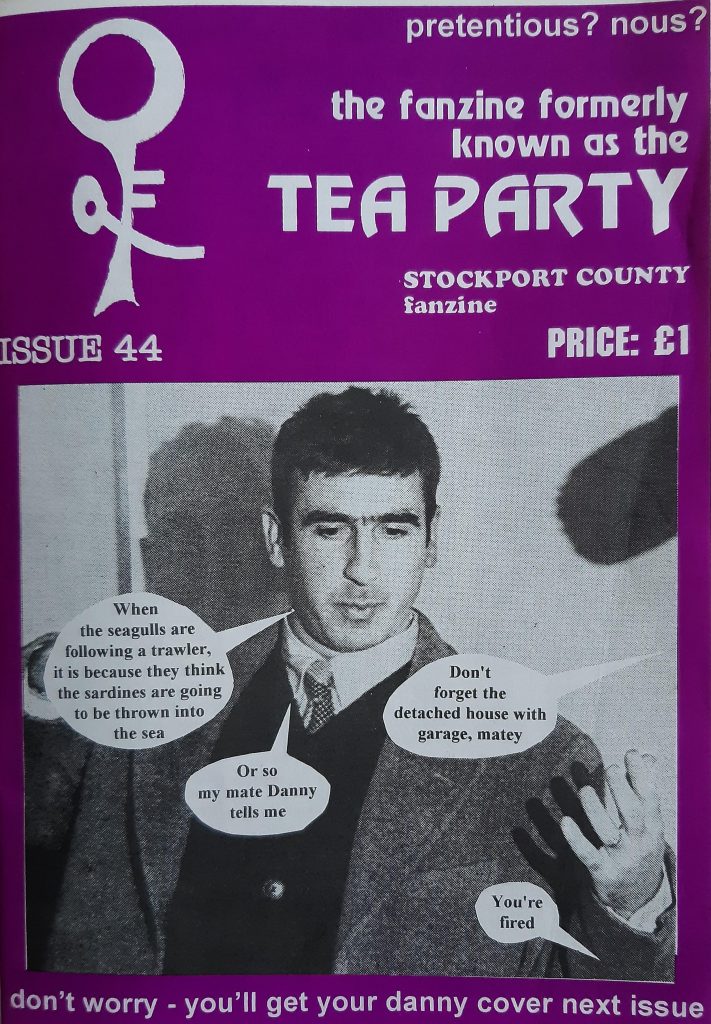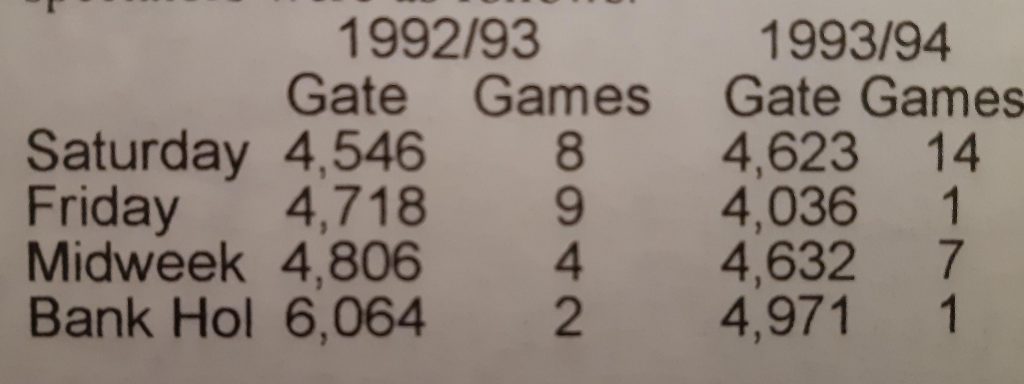THE NUMBERS GAME
..

In the previous issue I had wondered where the Club was heading. County were of course the original “Friday night” club – a policy which been all but deleted by Elwood. Personally I thought it was a retrograde move … and still do. This piece, using a statistical analysis, (my degree subject), to look at how the Club’s local support was drifting away … to the tune over £114,000 in a single year.
..
**************
..
A fair proportion of the last issue of TTP centred around the marked decline on the field and pointed to the impact this was having on the Club as a whole. Some of the letters mentioned the fall in gates which has been obvious to all. It got me to thinking about the various factors which influence attendances not only at EP but at football in general. The success, (or otherwise), of the team; prices; facilities; the weather on the day; the opposition and the attractiveness of a particular match will all contribute to the numbers who turn up for any match. Here at County we face particular issues such as the lack of covered standing, the demise of Friday football, and the recent lack of success on the field. Having a reasonable knowledge of statistical analysis I turned my mind as to the extent to which attendances at EP are influenced by these factors. Can they be measured?
To try and keep things relatively simple I considered four particular elements which I thought might have an influence.
Firstly the conditions . It would appear logical that people will be more attracted to a game if it’s warm and dry rather than cold and wet.
Secondly the day on which a game is played. The vast majority of fans at EP appear to favour Fridays rather than Saturdays but we also play midweek and occasionally on a Bank Holiday – are there any marked differences?
Thirdly is there such a thing as a local Derby anymore – with floating spectators more interested in coming to see us play Crewe, for example, rather than Bournemouth?
Lastly to what extent does the attractiveness of a fixture draw in the fans. Are they more likely to watch a top of the table clash rather than a mid table encounter or do County have a regular following and attract few casual spectators?
I’m sure that most of us will react fairly quickly to these themes and have ready answers but how far are these born out what happens in practice?
In order to test this I looked at the crowds for all home League games in 1992/93 and 1993/94 but excluded the visitors so as to give a true measure of how many locals came to the games. From memory, (may be failing in some instances), I came up with a measure of the weather conditions at the games. Knowing the opposition and the relative places at them and County in the League at the time of the game enabled a measure to be made of the attractiveness of the game. The computer was then set to work in order to see the quantifiable extent to which each of the four factors influenced the gate. The results were illuminating.
In total 46 games from the sample during that time County were hardly ever outside of the top four in the League and in general terms there were very few games played in really inclement conditions. There were a fair few juicy top of the table clashes with Stoke, West Brom, the Vale and Bolton. By excluding the number of visiting speccies, as listed in the programme, the local interest in the games could be evaluated. In crude terms the average local spectators were as follows:
..

The table included in TTP 44
..
On the face of it the view that Friday football is considerably more attractive than Saturday isn’t really borne out. Excluding the single Friday fixture in 1993, (Plymouth on a bad night the week before Christmas – hardly an attractive fixture), Fridays attracted just 172 more locals on average. However what should be remembered is that the decision of the board to play all the big matches (Stoke, West Brom etc), on a Saturday – games which would be more likely to attract more floaters will have increased that average. What was done next was to use a technique to separate out the extent to which the four factors in isolation affected attendances.
Arising from this analysis came the interesting conclusion but the conditions on match day have very little influence on the attendance which had I find surprising given that for the 1993/94 season there was precious little covered standing for home supporters. The old style derby matches ,where casual supporters might come along just for the local interest, appear to have gone by the wayside with practically next to no relationship between variations in the average attendance and the proximity or otherwise of the opposition.
There were two factors which appeared to have a direct impact on gates. Firstly the day on which the game is played. Saturday football is clearly the least popular with local supporters with on average 316 people less than there would be on a Friday, and 200 less than for a midweek fixture. Hardly surprising Bank Holiday matches attract the greatest number of floaters with the average home attendance being 1,400 more than on a Saturday.
Quite clearly however the attraction of the game in terms of relative positions of the two teams seems to have been the greatest contributory factor towards variations in attendances. For example a top of the table game would attract 600 more than if the two teams were in mid table. It’s quite obvious that there’s a sizeable element who need to be attracted to the Park rather than just coming automatically.
So where does this leave us other than me being satisfied that a new piece of computer software works OK!!
Elwood’s references to 5 year plans should hopefully, as a part of the Business Plan, have some means of reacting to information of this sort. It’s statistically provable the day on which a game is held does affect attendances. Equally importantly is the need to ensure that a game is attractive to the casual punter of which there appeared to be a significant number and that’s only done by ensuring that the team is near the top. It’s a pity a new stand won’t score many goals because if it did we have been in clover over the last month or two. Equally, a whole army of backroom staff will find themselves drastically underemployed if there’s nothing coming to watch. Which brings us to the rub.
If the Club has any pretension to effective business planning it will have forecast gate income for the 1994/95 season based on the sort of factors outlined above. Just in case they didn’t I’ve done the job for them and a salutary tale it tells.
After the Crewe match 19 home League games had been played. Using the trends identified from the 1992/93 and 1993/94 seasons It was possible to estimate the number of local spectators for each of those games taking into account the opposition, weather, and the relative positions of the teams at the time of the match. Only in 4 of the 19 games did the locals attend in greater numbers than the forecast, (being Bournemouth, Plymouth, Leyton and Chester), and even then the increase could be measured in handfuls. Of the other 15 games there was a worrying trend which saw on average 660 people less than could have been reasonably expected. Remember here that we’re not talking about visitors but purely about locals. The model takes care of variations expected to come from conditions, attractiveness of the games, and the day on which they were played so this alarming reduction can’t be explained away by that.
The last five years have seen a hard won increase in support – it’s clearly slipping away as a reaction to what’s being seen on the pitch. Despite the Board’s pronouncements about disappointments with crowd levels they really have got to face the fact that a significant element of what they had come to expect as the hardcore support has voted with their feet this year – that’s an average of £7.50 a time it’s £114,000 a season. Where I work we’ve stopped taking office and support staff the only new appointments that are made are frontline workers. Isn’t there a lesson to be learned?
March 1995


Recent Comments